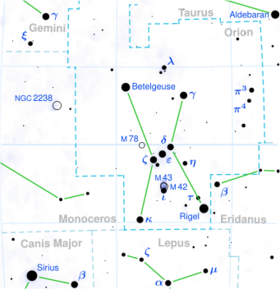Astronomy:11 Orionis
From HandWiki
Short description: Star in the constellation Orion
| Observation data Equinox J2000.0]] (ICRS) | |
|---|---|
| Constellation | Orion |
| Right ascension | 05h 04m 34.14916s[1] |
| Declination | +15° 24′ 14.7771″[1] |
| Apparent magnitude (V) | [2] 4.65 |
| Characteristics | |
| Spectral type | B9 IV[3] or A1 Vp SiCr[4] |
| U−B color index | −0.10[5] |
| B−V color index | −0.06[5] |
| Variable type | α² CVn[2] |
| Astrometry | |
| Radial velocity (Rv) | +16.80[6] km/s |
| Proper motion (μ) | RA: +17.80[1] mas/yr Dec.: −31.15[1] mas/yr |
| Parallax (π) | 8.93 ± 0.24[1] mas |
| Distance | 365 ± 10 ly (112 ± 3 pc) |
| Absolute magnitude (MV) | −0.59[7] |
| Details | |
| Radius | 3.6[8] R☉ |
| Luminosity | 220[7] L☉ |
| Temperature | 9,520[3] K |
| Rotational velocity (v sin i) | 36[9] km/s |
| Other designations | |
| Database references | |
| SIMBAD | data |
11 Orionis is a solitary[11] Ap star in the equatorial constellation of Orion, near the border with Taurus. It is visible to the naked eye with an apparent visual magnitude of 4.65,[7] and it is located approximately 365 light years away from the Sun based on parallax.[1] The star is moving further from the Sun with a heliocentric radial velocity of +16.8 km/s.[6]
This object is a chemically peculiar star, known as an Ap star, with enhanced silicon and chromium lines in its spectrum.[13] It is an α² CVn variable, ranging from 4.65 to 4.69 magnitude with a period of 4.64 days.[2] The magnetic field measured from metal lines has a strength of +160±390 G.[14]
References
- ↑ 1.0 1.1 1.2 1.3 1.4 1.5 Van Leeuwen, F. (2007). "Validation of the new Hipparcos reduction". Astronomy and Astrophysics 474 (2): 653–664. doi:10.1051/0004-6361:20078357. Bibcode: 2007A&A...474..653V. Vizier catalog entry
- ↑ 2.0 2.1 2.2 Samus, N. N. et al. (2009). "VizieR Online Data Catalog: General Catalogue of Variable Stars (Samus+ 2007-2013)". VizieR On-line Data Catalog: B/GCVS. Originally Published in: 2009yCat....102025S 1. Bibcode: 2009yCat....102025S.
- ↑ 3.0 3.1 Zorec, J.; Cidale, L.; Arias, M. L.; Frémat, Y.; Muratore, M. F.; Torres, A. F.; Martayan, C. (2009). "Fundamental parameters of B supergiants from the BCD system. I. Calibration of the (λ_1, D) parameters into Teff". Astronomy and Astrophysics 501 (1): 297–320. doi:10.1051/0004-6361/200811147. Bibcode: 2009A&A...501..297Z.
- ↑ Abt, Helmut A.; Morrell, Nidia I. (1995). "The Relation between Rotational Velocities and Spectral Peculiarities among A-Type Stars". Astrophysical Journal Supplement 99: 135. doi:10.1086/192182. Bibcode: 1995ApJS...99..135A.
- ↑ 5.0 5.1 Mermilliod, J. C. (2006). "VizieR Online Data Catalog: Homogeneous Means in the UBV System (Mermilliod 1991)". VizieR On-line Data Catalog: II/168. Originally Published in: Institut d'Astronomie 2168. Bibcode: 2006yCat.2168....0M.Vizier catalog entry
- ↑ 6.0 6.1 Wilson, R. E. (1953). "General Catalogue of Stellar Radial Velocities". Carnegie Institute Washington D.C. Publication (Carnegie Institution for Science). ISBN 9780598216885. Bibcode: 1953GCRV..C......0W.
- ↑ 7.0 7.1 7.2 Anderson, E.; Francis, Ch. (2012). "XHIP: An extended hipparcos compilation". Astronomy Letters 38 (5): 331. doi:10.1134/S1063773712050015. Bibcode: 2012AstL...38..331A. Vizier catalog entry
- ↑ Pasinetti Fracassini, L. E. et al. (February 2001). "Catalogue of Apparent Diameters and Absolute Radii of Stars (CADARS)". Astronomy and Astrophysics 367 (2): 521–524. doi:10.1051/0004-6361:20000451. Bibcode: 2001A&A...367..521P.
- ↑ Hoffleit, D.; Warren, W. H. (1995). "VizieR Online Data Catalog: Bright Star Catalogue, 5th Revised Ed. (Hoffleit+, 1991)". VizieR On-line Data Catalog: V/50. Originally Published in: 1964BS....C......0H 5050. Bibcode: 1995yCat.5050....0H.
- ↑ "11 Ori". SIMBAD. Centre de données astronomiques de Strasbourg. http://simbad.u-strasbg.fr/simbad/sim-basic?Ident=11+Ori.
- ↑ Eggleton, P. P.; Tokovinin, A. A. (September 2008). "A catalogue of multiplicity among bright stellar systems". Monthly Notices of the Royal Astronomical Society 389 (2): 869–879. doi:10.1111/j.1365-2966.2008.13596.x. Bibcode: 2008MNRAS.389..869E.
- ↑ "MAST: Barbara A. Mikulski Archive for Space Telescopes". Space Telescope Science Institute. https://mast.stsci.edu/portal/Mashup/Clients/Mast/Portal.html.
- ↑ Stigler, Ch.; Maitzen, H. M.; Paunzen, E.; Netopil, M. (2014). "Spectrophotometric analysis of the 5200 Å region for peculiar and normal stars". Astronomy & Astrophysics 562: A65. doi:10.1051/0004-6361/201322300. Bibcode: 2014A&A...562A..65S.
- ↑ Romanyuk, I. I. et al. (July 2016). "Results of magnetic field measurements of CP-stars performed with the 6-m telescope. III. Observations in 2009". Astrophysical Bulletin 71 (3): 302–313. doi:10.1134/S1990341316030056. Bibcode: 2016AstBu..71..302R.
 |



